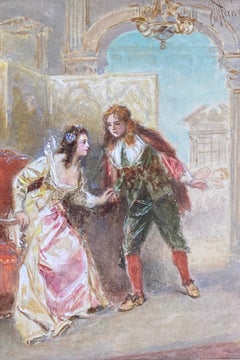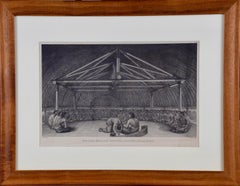Jean Leon Gerome Ferris Art
Jean Leon Gerome Ferris was an American painter best known for his series of 78 scenes from American history, entitled The Pageant of a Nation, the largest series of American historical paintings by a single artist. He was born in Philadelphia, Pennsylvania, on August 18, 1863, as the son of Stephen James Ferris, a portrait painter who was a devotee of Jean-Léon Gérôme (after whom he was named) and also an admirer of Mariano Fortuny. He grew up around art, having been trained by his father and having two acclaimed painters, Edward Moran and Thomas Moran, as uncles. Ferris enrolled in the Pennsylvania Academy of the Fine Arts in 1879 and trained further at the Académie Julian beginning in 1883 under William-Adolphe Bouguereau. He also met his namesake Jean-Léon Gérôme, who greatly influenced Ferris's decision to paint scenes from American history. As Ferris wrote in his unpublished autobiography, “Gérôme's axiom was that one would paint best that with which he is most familiar." His early subjects were Orientalist in nature, that movement having been in vogue when he was young. Some of his material was original, some of it took after Fortuny, but he was skilled enough, despite never having had any experience with art. In 1882, he exhibited a painting entitled Feeding the Ibis, which was valued at $600. By 1895, Ferris had gained a reputation as a historical painter and he embarked on his dream of creating a series of paintings that told a historical narrative. In 1898, he sold one of these, General Howe's Levee, 1777, but he later regretted it, realizing that such a series could not be complete if the separate paintings could not be kept together. Ferris, who had married Annette Amelia Ryder in 1894 and with whom he had a daughter named Elizabeth Mary, died in Philadelphia on March 18, 1930.
1890s Victorian Jean Leon Gerome Ferris Art
Watercolor, Gouache, Archival Paper
1880s Realist Jean Leon Gerome Ferris Art
Etching
1910s Art Deco Jean Leon Gerome Ferris Art
Gouache, Archival Paper, Pencil
1780s Realist Jean Leon Gerome Ferris Art
Engraving
1930s Art Deco Jean Leon Gerome Ferris Art
Archival Paper, Charcoal, Gouache
1920s Art Deco Jean Leon Gerome Ferris Art
Engraving, Aquatint
1890s Victorian Jean Leon Gerome Ferris Art
Gold
1860s Realist Jean Leon Gerome Ferris Art
Etching, Aquatint
1820s Realist Jean Leon Gerome Ferris Art
Printer's Ink, Rice Paper, Woodcut
17th Century Realist Jean Leon Gerome Ferris Art
Etching
2010s Contemporary Jean Leon Gerome Ferris Art
Conté, Gouache, Archival Paper
Early 19th Century Victorian Jean Leon Gerome Ferris Art
Paper, Watercolor
1960s Realist Jean Leon Gerome Ferris Art
Lithograph
Mid-20th Century Realist Jean Leon Gerome Ferris Art
Aquatint


